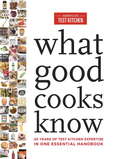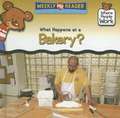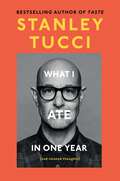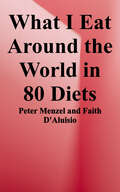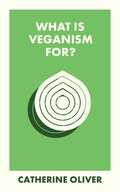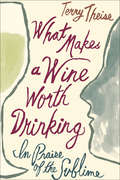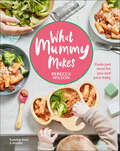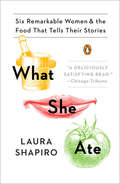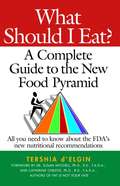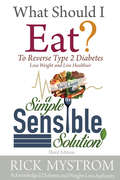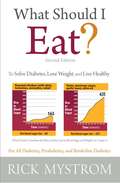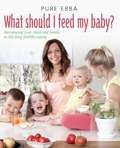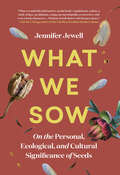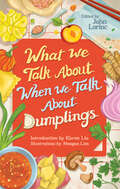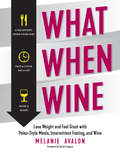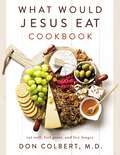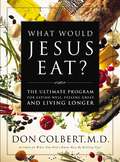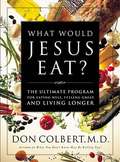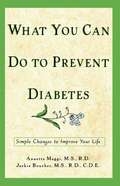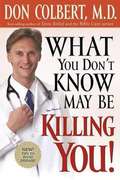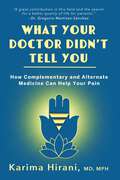- Table View
- List View
What Good Cooks Know: 20 Years of Test Kitchen Expertise in One Essential Handbook
by The Editors at America's Test KitchenAfter more than 20 years of obsessive research and testing, America's Test Kitchen has literally written the book on how to master your kitchen. Logically organized and packed with step photography, this will be the ultimate one-stop resource for both shopping and cooking. Have you ever wished that your kitchen came with instructions? Let the experts at America's most trusted test kitchen show you the ropes in this new illustrated compendium of techniques, tips, tricks, recipes, and reviews for the home cook. This is a handbook for everyone, beginner to expert, that is not only useful but also entertaining, thought-provoking, and utterly unique. It will appeal to longtime fans of the magazine who want to see behind the scenes as well as to novice cooks who want to get everything right in the kitchen from the beginning. Never before has America's Test Kitchen revealed the secrets behind our extensive testing procedures and exacting recipe development process; in this new book, come behind the scenes to see how we pick the best equipment and ingredients and create the most foolproof recipes out there. With dozens of equipment recommendations, hundreds of ingredient entries, mini lessons on basic cooking skills and useful kitchen science, plus illustrated step-by-step instructions for 50 of our most essential recipes.
What Happens At A Bakery? (Where People Work)
by Kathleen Pohl Susan NationsDescribes what Mr. Lopez the baker does when he makes a birthday cake for a customer.
What Happens to a Hamburger? (Let's-Read-and-Find-Out Science 2)
by Paul ShowersRead and find out about your digestive system in this colorfully illustrated nonfiction picture book.What happens to food when you eat it? Read and find out about your digestive system and how it turns food into energy your body can use.This is a clear and appealing science book for early elementary age kids, both at home and in the classroom. It's a Level 2 Let's-Read-and-Find-Out, which means the book explores more challenging concepts for children in the primary grades. The 100+ titles in this leading nonfiction series are:hands-on and visualacclaimed and trustedgreat for classroomsTop 10 reasons to love LRFOs:Entertain and educate at the same timeHave appealing, child-centered topicsDevelopmentally appropriate for emerging readersFocused; answering questions instead of using survey approachEmploy engaging picture book quality illustrationsUse simple charts and graphics to improve visual literacy skillsFeature hands-on activities to engage young scientistsMeet national science education standardsWritten/illustrated by award-winning authors/illustrators & vetted by an expert in the fieldOver 130 titles in print, meeting a wide range of kids' scientific interestsBooks in this series support the Common Core Learning Standards, Next Generation Science Standards, and the Science, Technology, Engineering, and Math (STEM) standards. Let's-Read-and-Find-Out is the winner of the American Association for the Advancement of Science/Subaru Science Books & Films Prize for Outstanding Science Series.
What I Ate in One Year: (and related thoughts)
by Stanley TucciFrom Stanley Tucci, award-winning actor and New York Times bestselling author, a deliciously unique memoir chronicling a year’s worth of meals. “Sharing food is one of the purest human acts.” Food has always been an integral part of Stanley Tucci’s life: from stracciatella soup served in the shadow of the Pantheon, to marinara sauce cooked between scene rehearsals and costume fittings, to home-made pizza eaten with his children before bedtime. Now, in What I Ate in One Year Tucci records twelve months of eating—in restaurants, kitchens, film sets, press junkets, at home and abroad, with friends, with family, with strangers, and occasionally just by himself. Ranging from the mouth-wateringly memorable to the comfortingly domestic and to the infuriatingly inedible, the meals memorialised in this diary are a prism for him to reflect on the ways his life, and his family, are constantly evolving. Through food he marks—and mourns—the passing of time, the loss of loved ones, and steels himself for what is to come. Whether it’s duck a l’orange eaten with fellow actors and cooked by singing Carmelite nuns, steaks barbequed at a gathering with friends, or meatballs made by his mother and son and shared at the table with three generations of his family, these meals give shape and add emotional richness to his days. What I Ate in One Year is a funny, poignant, heartfelt, and deeply satisfying serving of memories and meals and an irresistible celebration of the profound role that food plays in all our lives. <br><b>New York Times Bestseller</b></br>
What I Eat: Around the World in 80 Diets
by Faith D'AluisioA stunning photographic collection featuring portraits of 80 people from 30 countries and the food they eat in one day. In this fascinating study of people and their diets, 80 profiles are organized by the total number of calories each person puts away in a day. <p><p>Featuring a Japanese sumo wrestler, a Massai herdswoman, world-renowned Spanish chef Ferran Adria, an American competitive eater, and more, these compulsively readable personal stories also include demographic particulars, including age, activity level, height, and weight. <p><p>Essays from Harvard primatologist Richard Wrangham, journalist Michael Pollan, and others discuss the implications of our modern diets for our health and for the planet. This compelling blend of photography and investigative reportage expands our understanding of the complex relationships among individuals, culture, and food.
What Is Queer Food?: How We Served a Revolution
by John BirdsallA celebrated culinary writer’s expansive, audacious excavation of the roots of modern queer identity and food culture. The food on our plates has long been designed, twisted, and elevated by queer hands. Piecing together a dazzling mosaic of queer lives, spaces, and meals, beloved food writer John Birdsall unfolds the complex story of how, through times of fear and persecution, queer people used food to express joy and build community—and ended up changing the shape of the table for everyone. Tracing the evolution of queer food from the early decades of the twentieth century through the LGBTQ civil rights movement of post-Stonewall liberation and the devastation of AIDS, Birdsall fills the gaps between past and present. He channels the twin forces of criticism and cultural history to propel readers into the kitchens, restaurants, swirling party houses, and buzzing interior lives of James Baldwin, Alice B. Toklas, Truman Capote, Esther Eng, and others who left an indelible mark on the culinary world from the margins. Queer food, as Birdsall brilliantly reveals, is quiche and Champagne eleganza at Sunday brunch and joyous lesbian potlucks in the bunker world of Cold War homophobic purges. It’s paper chicken for the gender-rebel divas of Chinese opera in San Francisco, Richard Olney’s ecstatic salade composée, and Rainbow Ice-Box Cake from Ernest Matthew Mickler’s White Trash Cooking. It’s the intention surrounding a meal, the circumstances behind it, the people gathered around the table. With cinematic verve and delicious prose, What Is Queer Food? is a monumental work: a testament to food’s essential link to modern queerness that reveals how, like fashion or pop music, cooking and eating have become a crucial language of LGBTQ+ identity. By reframing our understanding of both food and queerness, it opens the door for courageous reckoning and boundless conversation.
What Is Veganism For? (What Is It For?)
by Catherine OliverAcross the world, an increasing number of people are turning to veganism, changing not just their diets, but completely removing animal products from their lives. For some, this is prompted by concerns over animal ethics; for others, it’s a response to the part played by animal agriculture in the climate crisis or an attempt to improve their own health. Catherine Oliver shows why the veganism movement has become a powerful social, political and environmental force, taking an honest look at how we live and eat. She discusses the health and environmental benefits of veganism, explores the practical and social impacts of the shift to eating plants, and explains why veganism is not just a diet, but a way of life.
What Makes a Wine Worth Drinking: In Praise of the Sublime
by Terry TheiseA paean to authentic wines and a New York Times Best Wine Book of the Year from the James Beard Award-winning author of Reading Between the Wines. What makes a wine worth drinking? As celebrated wine writer Terry Theise explains in this gem of a book, answering that seemingly simple question requires us to look beyond what&’s in our glass to consider much bigger questions about beauty, harmony, soulfulness, and the values we hold dear. Most of all, Theise shows, what makes a wine worth drinking is its authenticity. When we choose small-scale, family-produced wine over the industrially produced stuff, or when we opt for subtle, companionable wines over noisy, vulgar ones, we not only experience their origins with the greatest possible clarity and detail—we also gain a new perspective on ourselves and the world we inhabit. In this way, artisanal wine is not only the key to good drinking; it is also the key to a good life. An unforgettable literary journey into the heart and soul of wine, What Makes a Wine Worth Drinking is a gift to be cherished from a writer &“whose id is directly connected to his mouth&” (Eric Asimov, The New York Times). Winner of the Louis Roederer International Wine Writers&’ Awards Chairman&’s Award A &“Best Wine Gift&” by WineSpeed &“Grown-up wine writing, full of emotion . . . and, in these dangerously cynical times, exactly what we wine enthusiasts—we human beings—need.&”—The World of Fine Wine &“Theise&’s fans, as well as those just meeting him for the first time, will revel as he leads us on an existential tour of wine.&”—Dave McIntyre, The Washington Post
What Mummy Makes: Cook just once for you and your baby (What Mummy Makes Ser.)
by Rebecca Wilson130+ recipes all suitable from 6 months oldWean your baby and feed your family at the same time by cooking just one meal in under 30 minutes that everyone will enjoy!Say goodbye to cooking multiple meals every day and the nuisances of making special little spoonfuls for your baby, plainer dishes for fussy older siblings, and something different again for the grown-ups.With this ingenious new way to introduce solid food to your baby, you'll cook a single meal and eat it together as a family where the baby will learn how to eat from watching you. Each recipe is quick to prepare and easy to adapt for different ages and dietary requirements.So forget 'baby food' and make light work of weaning with What Mommy Makes!
What She Ate: Six Remarkable Women and the Food That Tells Their Stories
by Laura Shapiro"A collection of deft portraits in which food supplies an added facet to the whole.”—Slate“Mouthwatering.”—Eater.com A beloved culinary historian’s short takes on six famous women through the lens of food and cooking—what they ate and how their attitudes toward food offer surprising new insights into their lives.Everyone eats, and food touches on every aspect of our lives—social and cultural, personal and political. Yet most biographers pay little attention to people’s attitudes toward food, as if the great and notable never bothered to think about what was on the plate in front of them. Once we ask how somebody relates to food, we find a whole world of different and provocative ways to understand her. Food stories can be as intimate and revealing as stories of love, work, or coming-of-age. Each of the six women in this entertaining group portrait was famous in her time, and most are still famous in ours; but until now, nobody has told their lives from the point of view of the kitchen and the table. It’s a lively and unpredictable array of women; what they have in common with one another (and us) is a powerful relationship with food. They include Dorothy Wordsworth, whose food story transforms our picture of the life she shared with her famous poet brother; Rosa Lewis, the Edwardian-era Cockney caterer who cooked her way up the social ladder; Eleanor Roosevelt, First Lady and rigorous protector of the worst cook in White House history; Eva Braun, Hitler’s mistress, who challenges our warm associations of food, family, and table; Barbara Pym, whose witty books upend a host of stereotypes about postwar British cuisine; and Helen Gurley Brown, the editor of Cosmopolitan, whose commitment to “having it all” meant having almost nothing on the plate except a supersized portion of diet gelatin.
What Should I Eat?: A Complete Guide to the New Food Pyramid
by Tershia D'ElginThe must-have guide to the first revision of the food pyramid in over 13 years! For the first time in more than a decade, the U.S. Department of Agriculture has revised the Food Pyramid-the government's official recommendations concerning the nutrients our bodies require and the proportion of each we need to stay healthy. The new guidelines, called My Pyramid, have been significantly adjusted to reflect the latest scientific research on nutrition. They are also very confusing! What Should I Eat? helps clarify My Pyramid's vast and complicated information and tells you exactly what you need to know in order to benefit from the new nutritional guidelines. Moreover, this essential manual will show you how to tailor My Pyramid for your specific health and fitness needs. You will learn how to* Best meet the requirements of each food group* Eyeball portion sizes (What does an ounce look like?)* Gauge nutrition requirements for both women and men* Pack maximum nutrition into every meal* Make smart choices in restaurants* Incorporate exercise into your busy scheduleWith tips for shopping, storage, and cooking, and suggestions for seeking nutritional supplements and professional care, What Should I Eat? is your ultimate roadmap to a long and healthy life.From the Trade Paperback edition.
What Should I Eat?: Solve Diabetes, Lose Weight, and Live Healthy
by Rick MystromWhat Should I Eat is based on 80,000 blood tests taken after nearly every meal the author's eaten for the past 34 years. What Should I Eat will be life changing if: you're aTYPE2 DiABETiC who wants to lower your blood sugar and lose weight, or you're a PREDiABETiC or BoRDERliNE DiABETiC who wants to avoid ever getting diabetes, or you're a TYPE 1 DiABETiC who wants to improve blood sugar control and live a long, healthy life, or you're one of the two thirds of American adults who want to Lose Weight!
What Should I Eat?: Solve Diabetes, Lose Weight, and Live Healthy
by Rick MystromWhat Should I Eat is based on 60,000 blood tests taken after nearly every meal the author's eaten for the past 34 years. What Should I Eat will be life changing if: you'reaTYPE2 DiABETiC who wants to lower your blood sugar and lose weight, or you're a PREDiABETiC or BoRDERliNE DiABETiC who wants to avoid ever getting diabetes, or you're a TYPE 1 DiABETiC who wants to improve blood sugar control and live a long, healthy life, or you're one of the two thirds of American adults who want to lLose Weight!
What Should I Feed My Baby: Introducing Your Child To Life-long Healthy Eating
by Pure EbbaWhat should I feed my baby? is a simple but thorough guide for parents who want to introduce their baby to wholesome and nutritious food right from the start. Even if you are not skilled in the kitchen you will learn how to cook fresh and natural food so that you know your baby is receiving only the healthiest foods. This book takes a parent from baby's first taste of solid food at around 4/6 to 12 months and beyond, and includes: A detailed list of organic and superfoods that your baby can eat at particular ages; Guidelines on fruit, vegetables, seeds, whole grains, nuts and superfoods; Simple recipes for babies and young children; Healthy recipes for the whole family to enjoy together; Healthy and delicious recipes for special occasions, such as baby's birthday! Ebba sees herself as a new Annabel Karmel, but with a stronger focus on introducing superfoods to your baby at the weaning stage so that they become part of their everyday diet. This book is not just about what your baby can eat at different stages but about what are the best and most nutritional foods for them to eat in order to develop into healthy and strong children.
What Was It Before It Was Bread?
by Jane Belk MoncureTraces the process by which wheat is grown, cut, ground into different kinds of flour, and baked into bread. Includes a recipe for whole wheat muffins.
What Was It Before It Was Ice Cream?
by Colleen Reece Jane BuergerHow is ice cream made and what goes into making ice cream? How can you make ice cream at home? Find out in this book with a recipe for ice cream.
What We Sow: On the Personal, Ecological, and Cultural Significance of Seeds
by Jennifer JewellAn insightful, personal, and timely exploration into the wonderful world of seeds. In What We Sow, Jennifer Jewell brings readers on an insightful, year-long journey exploring the outsize impact one of nature's smallest manifestations—the simple seed. She examines our skewed notions where "organic" seeds are grown and sourced, reveals how giant multinational agribusiness has refined and patented the genomes of seeds we rely on for staples like corn and soy, and highlights the efforts of activists working to regain legal access to heirloom seeds that were stolen from Indigenous peoples and people of color. Throughout, readers are invited to share Jewell's personal observations as she marvels at the glory of nature in her Northern California hometown. She admires at the wild seeds she encounters on her short daily walks and is amazed at the range of seed forms, from cups and saucers to vases, candelabras, ocean-going vessels, and airliners. What We Sow is a tale of what we choose to see and what we haven't been taught to see, what we choose to seed and what we choose not to seed. It urgently proves that we must work hard to preserve and protect the great natural diversity of seed.
What We Talk About When We Talk About Dumplings
by John LorincNearly every culture has a variation on the dumpling: histories, treatises, family legends, and recipes about the world’s favourite lump of carbs If the world's cuisines share one common food, it might be the dumpling, a dish that can be found on every continent and in every culinary tradition, from Asia to Central Europe to Latin America. Originally from China, they evolved into ravioli, samosas, momos, gyozas, tamales, pierogies, matzo balls, wontons, empanadas, potato chops, and many more. In this unique anthology, food writers, journalists, culinary historians, and musicians share histories of their culture’s version of the dumpling, family dumpling lore, interesting encounters with these little delights, and even recipes to unwrap the magic of the world's favourite dish. With an introduction by Karon Liu. Illustrations by Meegan Lim. Contributors include: Michal Stein, Christina Gonzales, Kristen Arnett, David Buchbinder, André Alexis, Miles Morrisseau, Angela Misri, Perry King, Sylvia Putz, Mekhala Chaubal, Arlene Chan, Chantal Braganza, Naomi Duguid, Eric Geringas, Matthew Murtagh-Wu, Monika Warzecha, Bev Katz Rosenbaum, Tatum Taylor Chaubal, Domenica Marchetti, Julie Van Rosendaal, Amy Rosen, Cheryl Thompson, Jennifer Jordan, Marie Campbell, Navneet Alang
What When Wine: Lose Weight And Feel Great With Paleo-style Meals, Intermittent Fasting, And Wine
by Melanie Avalon Sarah FragosoAn effortless—really!—approach that turns the body into a fat-burning machine. Is it possible to eat well, drink wine, and still lose weight? Melanie Avalon is living proof that, heck yeah, it’s not only possible, it’s unbelievably simple and straightforward. It’s all about the what (mostly Paleo, but she’s not a monster about it), the when (believe it or not, brief fasting can mean freedom rather than restriction), and the wine (red wine can be a secret bullet for weight loss—who knew?). It’s a combination that Avalon discovered after years of self-experimentation and intense research on the mechanics of body fat regulation. In What When Wine, Avalon shares her journey to a healthier lifestyle, with the tips and tricks she learned along the way, as well as a jumpstart plan including 50 delicious Paleo-friendly, gluten-free recipes by chef Ariane Resnick.
What Would Jesus Eat Cookbook
by Don ColbertIf you want to live a healthier lifestyle that aligns with your faith, the What Would Jesus Eat Cookbook is a resource that provides more than 90 nutritional recipes and life-changing information to help you improve your health. This is not just a cookbook; it&’s a health resource you&’ll use all year.This renewed edition of the What Would Jesus Eat Cookbook is a compilation that features content and recipes from What Would Jesus Eat? along with comprehensive updates based on new studies and data within the health industry.Inside you&’ll find:more than 90 simple yet healthy recipes that anyone can make.key takeaways at the end of each chapter that provide answers to frequently asked questions.information about anxiety, autoimmune disorders, cancer, diabetes, fatigue, food allergies, inflammation, insomnia, Lyme disease, memory loss, migraines, thyroid disease, and weight loss.helpful advice to help you choose organic options and eat clean.tips on freezing foods, baking pan suggestions based on cups/servings, and emergency ingredient substitution suggestions.Dr. Colbert has been a board-certified family practice doctor for more than 25 years. He is also board-certified through the American Academy of Anti-Aging Medicine and has received extensive training in nutritional and preventative medicine. What Would Jesus Eat Cookbook presents "the Jesus way of eating." If you truly want to follow Jesus in every area of your life. you cannot ignore your eating habits. Are you willing to make a commitment to follow Jesus' example and eat the way He ate?
What Would Jesus Eat?: The Ultimate Program For Eating Well, Feeling Great, And Living Longer
by Don ColbertThough there are many diet programs claiming to be "God's way" to healthy living, and while some of them are based on biblical principles, and even have proven effective for weight loss, What Would Jesus Eat? is the first to note the obvious health benefits of what Jesus ate. In this comprehensive program, Dr. Don Colbert reveals the sensible approach to healthy eating laid out by the ultimate role model. Readers will discover:Why foods forbidden in the Old Testament are unhealthyJesus's favorite foods, including "fast foods" and dessertThe health benefits of foods Jesus ate, and the health risks of foods He avoidedAlso included are Dr. Colbert's tools to effectively follow the plan: recipes, nutritional information, and practical advice, including how to follow Jesus's model of eating with foods readily available today.
What Would Jesus Eat?: The Ultimate Program for Eating Well, Feeling Great, and Living Longer
by Don ColbertDoes Scripture teach us how to live and eat? Based on medical and historical research, this health specialist says yes! Dr. Colbert shows you why those foods Jesus ate are ideal for 21st-century living---and why those he avoided continue to pose health risks. Discover a comprehensive nutrition plan that incorporates Bible-based eating.
What You Can Do To Prevent Diabetes
by Annette Maggi Jackie BoucherThis is composed of eight parts, in them you will find among other things, a simple changes journal, and realistic examples of how the plan they outline can be applied to every-day life.
What You Don't Know May Be Killing You
by Don ColbertYou know that proper diet, exercise, and rest can keep you in good health, but perhaps you wonder if you're doing enough. Perhaps you've seen family members and friends who took care of themselves devastated by illness. Was there something they could have done to prevent the disease or illness. The truth is...what you don't know may be killing you. Dr. Don Colbert's answers and updated information may surprise you AND help you!
What Your Doctor Didn't Tell You: How Complementary and Alternative Medicine Can Help Your Pain
by Dr. Karima HiraniHelp with your pain is within reach! Let Dr. Karima Hirani teach you the most advanced therapies from alternative and complementary medicine for your pain.One in five American adults suffer from chronic pain and it affects over a billion people globally. While consumers spend billions of dollars on over-the-counter and prescription remedies, the usual outcomes of standard pain management are dismal. So, why are pain sufferers told so often that they need to live with their pain? Pain can impact every aspect of our lives from overall wellbeing and psychological health to economic and social welfare. Anxiety, depression, insomnia, and stress are four of the most common symptoms that accompany chronic pain—but all are actually treatable. For decades, Dr. Karima Hirani achieved successful treatment for thousands of pain sufferers. What Your Doctor Didn&’t Tell You: How Complementary and Alternative Medicine Can Help Your Pain offers readers a less invasive, natural, integrative approach that can finally provide them with relief. Combining the most advanced therapies from alternative and complementary medicine, her book shows how pain sufferers can improve their quality of life, performance, and prevention—and much more including: How Mother Nature&’s pulsed electromagnetic fields work to resolve pain;The secret treatment which helped President Kennedy with his chronic back pain that you can also use;How Oxygen-ozone therapy succeeds when other pain treatments fail;How to manage your gut-brain axis to control inflammation and pain;How the allergy elimination diet with exercise can bring about a 25 - 30 percent improvement of pain; andThat not all knee pain is osteoarthritis, so you may not need that knee replacement.As Dr. Hirani says, "You don't need to let another day go by with pain!"
